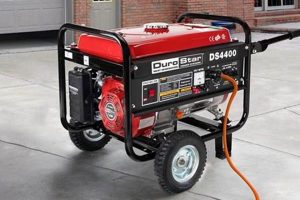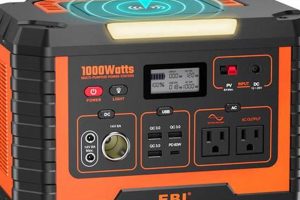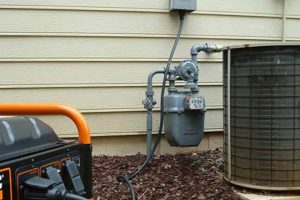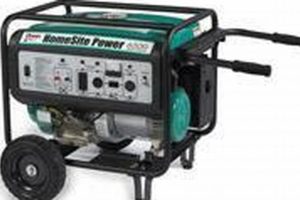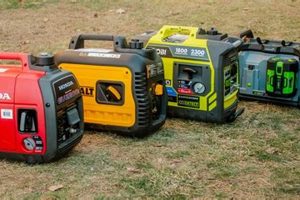Providing backup power during outages is a critical consideration for homeowners. Smaller, mobile generators offer a convenient solution for powering essential appliances or devices. However, supplying electricity to an entire residence requires careful consideration of power demands and generator capacity. Successfully powering a whole house during a power outage depends on the size of the home, the types of appliances used, and the output capabilities of the generator.
Reliable backup power offers peace of mind, enabling the continued operation of essential systems like heating, cooling, refrigeration, and lighting. This capability is especially valuable during extended outages caused by severe weather events or grid failures. Historically, homeowners relied on permanently installed standby generators for whole-house backup power. The increasing availability and affordability of portable units now provides a flexible alternative. This flexibility makes them an attractive option for those seeking a balance between cost and capability.
The following sections delve into the key factors influencing the choice of a suitable generator, including power requirements, fuel types, safety considerations, and the practical aspects of connecting a generator to a home’s electrical system. Understanding these elements will help determine whether a portable solution can effectively meet whole-house power needs.
Tips for Whole-House Generator Power
Ensuring adequate power during an outage requires careful planning and execution. These tips offer guidance for using a portable generator effectively and safely.
Tip 1: Calculate Power Requirements: Determine the wattage needed to run essential appliances. Add the wattage of each item to understand the total power demand. Consider both starting and running wattage, as some appliances require a higher surge of power upon startup.
Tip 2: Choose the Right Generator Size: Select a generator with sufficient running wattage to meet calculated needs. Opting for slightly higher capacity provides a buffer for unexpected loads.
Tip 3: Prioritize Essential Appliances: Decide which appliances are critical during an outage. Focus on necessities like refrigerators, freezers, lighting, and heating or cooling systems.
Tip 4: Use a Transfer Switch: A transfer switch safely connects the generator to the home’s electrical system, preventing backfeeding and protecting utility workers.
Tip 5: Follow Safety Guidelines: Operate the generator outdoors in a well-ventilated area, away from windows and doors. Never refuel a hot generator.
Tip 6: Consider Fuel Type and Storage: Evaluate fuel options based on availability, cost, and storage capacity. Ensure adequate fuel storage for extended outages.
Tip 7: Regular Maintenance: Perform regular maintenance checks, including oil changes and air filter cleaning, to ensure optimal generator performance.
By following these guidelines, homeowners can effectively leverage portable generators to provide crucial backup power during outages, ensuring safety and maintaining essential functions.
This proactive approach to power management allows households to weather unexpected interruptions comfortably and safely.
1. Generator Size (Wattage)
Generator size, measured in watts, is a pivotal factor in determining whether a portable generator can effectively power a whole house. Adequate wattage is essential to meet the combined power demands of various household appliances and systems. Selecting an undersized generator can lead to overloads, while an oversized unit represents unnecessary expense and potential fuel inefficiency.
- Running Watts vs. Starting Watts
Understanding the distinction between running watts and starting watts is crucial. Running watts represent the power required for continuous operation, while starting watts refer to the surge of power needed to initiate an appliance, particularly those with motors like refrigerators and air conditioners. For example, a refrigerator might require 1,000 starting watts but only 200 running watts. Accurately assessing both values is essential for proper generator sizing.
- Calculating Total Power Requirements
Calculating the total power requirement involves summing the running watts of all intended appliances. Adding a safety margin of 20-30% is advisable to accommodate fluctuations and potential future needs. For instance, a household with a combined running wattage requirement of 4,000 watts should ideally select a generator with a capacity of at least 4,800-5,200 watts. This calculation is fundamental to answering the question of whole-house power feasibility.
- Matching Generator Capacity to Home Size
Generator capacity requirements typically correlate with home size. Smaller homes with fewer appliances and limited electrical demands can often be powered by smaller, more portable generators. Larger homes, especially those with central air conditioning, electric heating, or multiple large appliances, necessitate significantly higher wattage outputs. This relationship between home size and generator capacity is a primary consideration in whole-house power planning.
- Impact of Fuel Consumption
Generator size directly impacts fuel consumption. Larger generators generally consume more fuel per hour. Choosing a generator with appropriate wattage, neither too large nor too small, optimizes fuel efficiency and reduces operational costs during extended outages. This factor plays a significant role in the long-term practicality of whole-house generator power.
Selecting the correct generator size is therefore paramount for successful whole-house power. Accurate wattage calculations, coupled with a clear understanding of starting and running watts, ensures the generator can handle the load, preventing overloads and maximizing efficiency. This careful consideration of wattage ultimately dictates the viability and effectiveness of using a portable generator for whole-house power backup.
2. Power Requirements
Accurately assessing power requirements is fundamental to determining whether a portable generator can effectively power a whole house. Understanding the electrical demands of a household is the first step in selecting an appropriately sized generator and ensuring sufficient power during an outage. This assessment involves identifying essential appliances, calculating their wattage needs, and considering potential future demands.
- Essential Appliances
Identifying essential appliances is crucial for determining minimum power needs. These appliances typically include refrigerators, freezers, sump pumps, furnaces, and essential lighting. Prioritizing these appliances helps establish a baseline power requirement for maintaining basic functionality during an outage. For instance, a household might prioritize refrigeration, lighting, and a well pump for water access, while foregoing less critical appliances like ovens or entertainment systems.
- Wattage Calculation
Calculating the wattage requirements of each essential appliance is necessary for determining the total power demand. Appliance wattage information is typically found on a label or in the owner’s manual. Summing the wattage of each essential appliance provides a comprehensive picture of the household’s power needs. Consider both running watts (power for continuous operation) and starting watts (surge power needed for startup), especially for appliances with motors. For example, a refrigerator might require 200 running watts and 1000 starting watts.
- Future Demands and Expansion
Anticipating potential future power needs is important for long-term planning. Consider potential additions to the household, such as new appliances or electrical systems, that might increase power demands. Selecting a generator with slightly higher capacity than current needs can accommodate future expansion and avoid the need for a larger generator later. This forward-thinking approach ensures the generator remains adequate for evolving household requirements.
- Load Management
Strategic load management is vital for optimizing generator usage and avoiding overloads. This involves prioritizing essential appliances and staggering their operation to minimize peak demand. For instance, running the washing machine and dryer at separate times can prevent exceeding the generator’s capacity. Effective load management ensures efficient power distribution during an outage and maximizes the generator’s runtime.
Accurate power requirement analysis directly informs generator selection. Understanding the combined wattage needs of essential appliances, considering future demands, and implementing load management strategies are critical for determining whether a portable generator can realistically and effectively power a whole house during an outage. This assessment provides the foundation for a reliable and efficient backup power solution.
3. Transfer Switch
Safe and effective whole-house generator operation necessitates a transfer switch. This device plays a critical role in isolating the home’s electrical system from the utility grid when operating on generator power. A transfer switch prevents dangerous backfeeding, which can harm utility workers and damage appliances. It also streamlines the process of switching between utility and generator power.
- Safety and Backfeeding Prevention
A transfer switch’s primary function is to prevent backfeeding, a phenomenon where electricity flows from the generator back into the utility grid. This poses a significant electrocution risk to utility workers repairing downed power lines. Transfer switches physically disconnect the home’s wiring from the utility grid, ensuring complete isolation and safety during generator operation. This safety aspect is paramount for responsible generator usage.
- Types of Transfer Switches
Several transfer switch types exist, each with specific applications. Manual transfer switches require manual operation to switch between utility and generator power. Automatic transfer switches detect outages and automatically activate the generator, providing seamless power transition. The choice depends on budget and desired level of automation. For whole-house power, a properly sized transfer switch capable of handling the generator’s output is essential. Consulting a qualified electrician is recommended for installation and selection.
- Installation and Professional Assistance
Transfer switch installation requires electrical expertise and should be performed by a qualified electrician. Correct wiring and adherence to local electrical codes are critical for safety and proper operation. Incorrect installation can lead to malfunctions, safety hazards, and potential damage to appliances. Professional installation ensures compliance with safety standards and optimizes performance.
- Legal and Code Compliance
Many jurisdictions require transfer switches for generator connections to the home’s electrical system. These regulations aim to safeguard utility workers and ensure electrical safety. Homeowners should consult local authorities to verify code requirements before installing a generator and transfer switch. Compliance ensures legal operation and avoids potential penalties.
A transfer switch is therefore an integral component for safely and effectively powering a whole house with a portable generator. Its role in backfeeding prevention, streamlined power transfer, and adherence to safety standards is crucial. Understanding transfer switch types, professional installation requirements, and legal compliance considerations ensures proper and safe integration of generator power into a home’s electrical system, directly impacting the feasibility and safety of whole-house generator usage.
4. Fuel Supply
Fuel supply is a critical consideration when determining the feasibility of using a portable generator for whole-house power. A consistent and adequate fuel source is essential for sustained generator operation during extended power outages. Understanding fuel types, storage requirements, consumption rates, and logistical considerations is paramount for effective power management.
- Fuel Type and Availability
Portable generators typically utilize gasoline, propane, or diesel fuel. Gasoline is readily available but has a limited shelf life and poses storage challenges. Propane offers extended storage stability but requires larger tanks. Diesel provides high efficiency but can be more expensive. Fuel availability during emergencies should be considered, as supply disruptions can occur. Choosing a readily available fuel type and establishing reliable supply channels are essential for uninterrupted power.
- Storage Capacity and Safety
Safe and adequate fuel storage is paramount for extended generator operation. Properly sized and sealed containers are essential to prevent spills, leaks, and fire hazards. Storing fuel in a well-ventilated area away from ignition sources is crucial for safety. Calculating fuel requirements based on generator consumption rates and anticipated outage durations ensures sufficient reserves. Adhering to safety regulations regarding fuel storage is essential for mitigating risks.
- Consumption Rate and Runtime
Generator fuel consumption rates vary based on load and generator size. Higher power demands lead to increased fuel consumption. Understanding the generator’s fuel consumption rate at various loads is crucial for estimating runtime based on available fuel reserves. This calculation informs decisions regarding fuel storage capacity and refueling frequency. Efficient load management can extend runtime and reduce fuel consumption.
- Refueling Logistics and Safety
Refueling a generator during an extended outage requires careful planning and adherence to safety procedures. Allowing the generator to cool completely before refueling is essential to prevent fire hazards. Having adequate fuel reserves readily available minimizes downtime during refueling. Understanding proper refueling techniques and safety protocols ensures safe and efficient operation.
Adequate fuel supply directly impacts the practicality and effectiveness of using a portable generator for whole-house power. Careful consideration of fuel type, storage, consumption rates, and refueling logistics ensures uninterrupted operation during outages. Proactive fuel management is essential for a reliable backup power solution, directly influencing the viability of powering an entire home with a portable generator.
5. Safety Procedures
Safe operation is paramount when utilizing a portable generator for whole-house power. Overlooking safety procedures can lead to serious consequences, including carbon monoxide poisoning, fire hazards, and electrical shocks. Understanding and implementing proper safety protocols is crucial for protecting individuals and property.
- Ventilation and Carbon Monoxide Poisoning
Generators produce carbon monoxide, a colorless, odorless, and highly toxic gas. Operating a generator indoors or in poorly ventilated areas can lead to rapid carbon monoxide buildup, resulting in severe health consequences or even fatalities. Adequate ventilation is crucial. Generators should always be placed outdoors, far from windows, doors, and vents, to ensure safe exhaust dispersal.
- Fire Hazards and Fuel Handling
Generators pose fire risks due to the presence of flammable fuel. Spilled fuel, improper refueling procedures, and proximity to flammable materials can ignite fires. Allowing the generator to cool completely before refueling is essential. Storing fuel in approved containers and away from ignition sources minimizes fire hazards. A fire extinguisher should be readily available near the generator.
- Electrical Safety and Grounding
Improper electrical connections and grounding can lead to electrical shocks and equipment damage. Using a properly installed transfer switch is crucial for safely connecting the generator to the home’s electrical system. Dry hands and avoiding contact with water during operation minimize shock risks. Ensuring the generator is properly grounded protects against electrical faults.
- Weather Protection and Operation
Operating a generator in wet or inclement weather increases electrical hazards. Protecting the generator from rain and snow is vital for safe operation. Using a generator cover designed for outdoor use helps prevent water damage and electrical shorts. Operating the generator on a dry, stable surface minimizes risks.
Adherence to safety procedures is non-negotiable when using a portable generator for whole-house power. Ignoring these precautions can have dire consequences. Prioritizing proper ventilation, safe fuel handling, electrical safety, and weather protection mitigates risks and ensures the safe and effective operation of a portable generator during power outages. Careful consideration of these safety aspects directly impacts the feasibility and responsibility of using a portable generator for whole-house power.
6. Local Regulations
Operating a portable generator for whole-house power is subject to local regulations designed to ensure safety and minimize community impact. These regulations vary by jurisdiction and address aspects such as noise levels, permitted operating hours, installation requirements, and emissions standards. Compliance with these regulations is crucial for responsible generator usage and avoiding potential penalties.
- Noise Ordinances
Many localities have noise ordinances that restrict the permissible decibel levels produced by generators. These regulations aim to minimize noise pollution and maintain community quiet. Generators exceeding permitted noise levels may be subject to fines or restrictions on operating hours. Understanding local noise ordinances and selecting quieter generator models are important for compliance.
- Permitted Operating Hours
Some jurisdictions enforce restrictions on generator operating hours, particularly during nighttime or early morning periods. These regulations balance the need for backup power with residents’ right to a peaceful environment. Operating a generator outside permitted hours may result in penalties. Awareness of local time restrictions is essential for compliant operation.
- Permitting and Installation Requirements
Certain areas require permits for installing and operating portable generators for whole-house power. These permits often involve inspections to ensure compliance with safety standards and electrical codes. Failing to obtain necessary permits can lead to fines or legal action. Consulting local authorities regarding permitting requirements is essential before installation.
- Emissions Standards
Environmental regulations concerning generator emissions are increasingly common. These regulations aim to minimize air pollution and protect public health. Generators must meet specific emissions standards to comply. Choosing generators certified to meet local emissions requirements is crucial for responsible operation and environmental compliance.
Local regulations play a significant role in determining the feasibility and legality of using a portable generator for whole-house power. Understanding and complying with these regulations, including noise ordinances, permitted operating hours, installation permits, and emissions standards, is essential for responsible generator usage. Ignoring these requirements can lead to penalties and jeopardize the ability to utilize a generator for backup power, thus directly impacting the practicality of whole-house generator operation.
Frequently Asked Questions
This section addresses common inquiries regarding the use of portable generators for whole-house power, providing concise and informative responses to clarify potential uncertainties.
Question 1: What size portable generator is needed to power an average home?
Generator sizing depends on the specific power requirements of the home. Calculating the total wattage of essential appliances is crucial. While a 5000-watt generator might suffice for basic needs in a smaller home, larger residences or those with high-demand appliances like central air conditioning may require 10,000 watts or more. Professional consultation is recommended for accurate assessment.
Question 2: Is it safe to connect a portable generator directly to household wiring?
Direct connection is unsafe and strongly discouraged. A properly installed transfer switch is essential for safe connection, preventing backfeeding and protecting utility workers. Direct connection poses significant risks, including electrocution and equipment damage.
Question 3: What type of fuel is most suitable for whole-house generator operation?
Fuel choice depends on factors like availability, storage capacity, and budget. Gasoline is readily available but has a limited shelf life. Propane offers longer storage but requires larger tanks. Diesel provides high efficiency but can be more expensive. Each fuel type has advantages and disadvantages.
Question 4: How long can a portable generator run continuously?
Runtime depends on generator size, fuel capacity, and load. Larger generators with larger fuel tanks generally provide longer runtimes. Higher power demands reduce runtime. Calculating estimated runtime based on fuel consumption rates and anticipated load is essential.
Question 5: Where should a portable generator be placed during operation?
Generators must be operated outdoors in a well-ventilated area, far from windows, doors, and vents. This precaution is essential to prevent carbon monoxide buildup, a serious health hazard. Never operate a generator indoors or in enclosed spaces.
Question 6: Are there any legal restrictions on using a portable generator for whole-house power?
Local regulations vary regarding generator usage. Some jurisdictions require permits, impose noise restrictions, or limit operating hours. Consulting local authorities is crucial to ensure compliance and avoid potential penalties.
Careful consideration of these frequently asked questions provides valuable insights into the complexities and safety considerations associated with using portable generators for whole-house power. Understanding these aspects is crucial for responsible and effective implementation of backup power solutions.
For further information and guidance, consult qualified electricians and local authorities regarding specific requirements and recommendations for safe and compliant generator usage.
Conclusion
Determining whether a portable generator can power a whole house requires careful evaluation of several interconnected factors. Generator size must align with the home’s power demands, calculated by summing the wattage of essential appliances and systems. Safe implementation necessitates a properly installed transfer switch to prevent backfeeding and isolate the home’s electrical system from the utility grid. Fuel supply considerations, including fuel type, storage capacity, and consumption rates, are crucial for sustained operation during extended outages. Adherence to safety procedures, encompassing proper ventilation, fuel handling, and electrical precautions, is paramount for mitigating risks. Finally, compliance with local regulations regarding noise levels, operating hours, permitting, and emissions standards ensures legal and responsible generator usage.
Careful planning and thorough consideration of these elements are essential for effectively leveraging a portable generator for whole-house power. Investing in a properly sized generator, coupled with professional installation and adherence to safety guidelines, provides a reliable backup power solution, enhancing resilience during unforeseen outages. Proactive preparation empowers homeowners to maintain essential functions and navigate power disruptions safely and efficiently.

